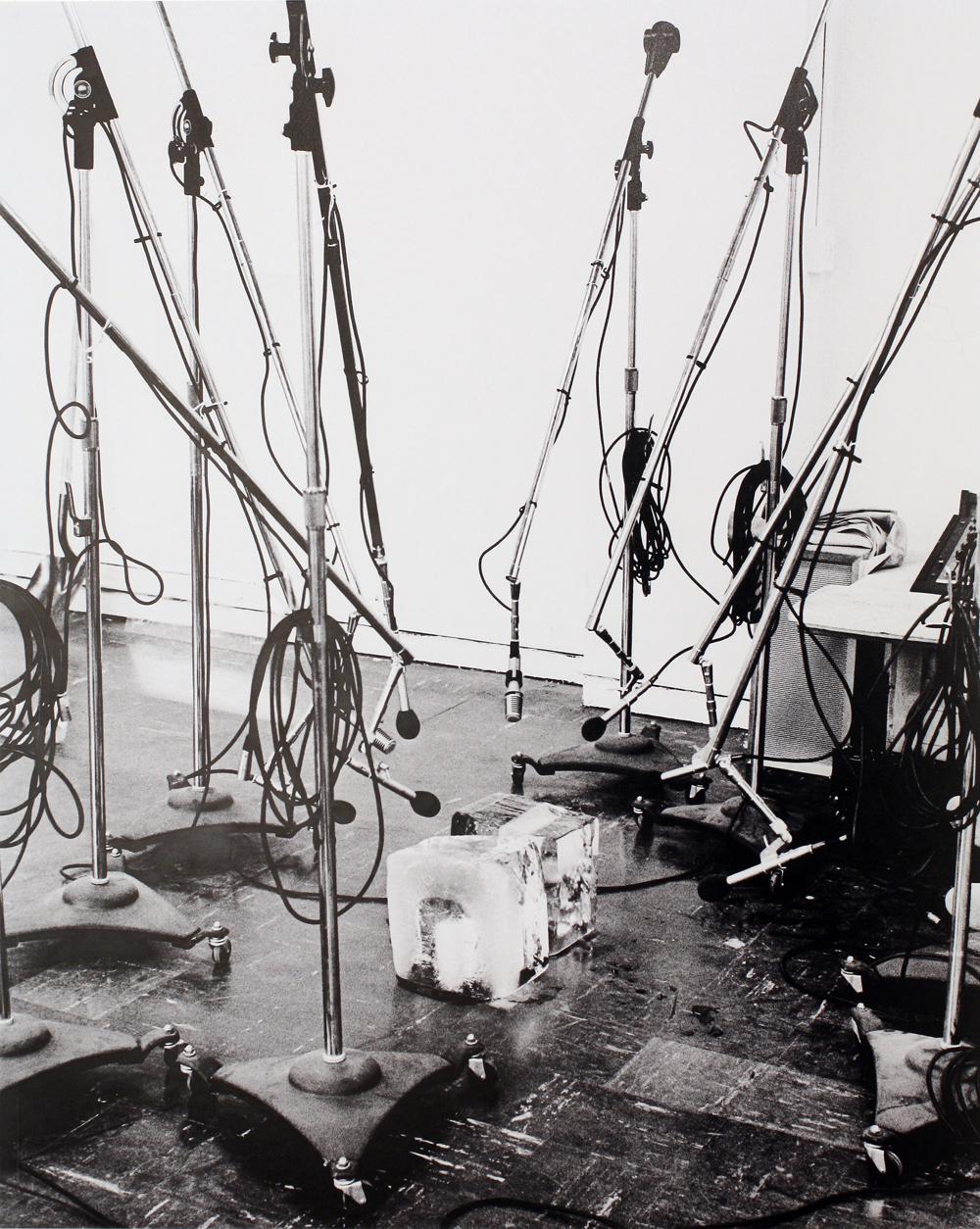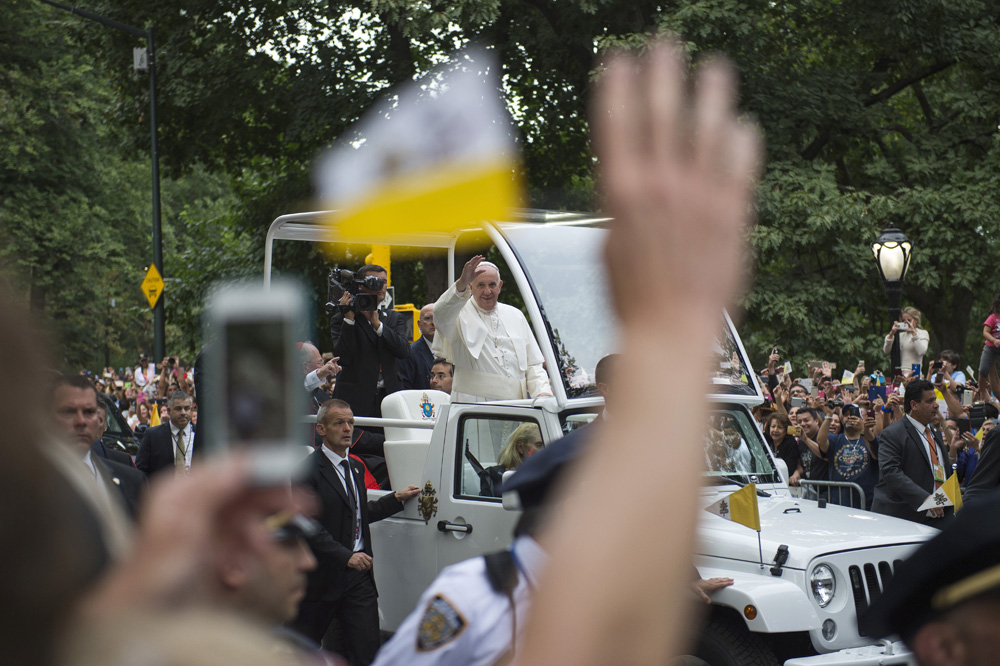The following essay will appear in Climates: Architecture and the Planetary Imaginary, published this spring by the Avery Review and Lars Müller Publishers.

Many years later, as he faced the firing squad, Colonel Aureliano Buendía was to remember that distant afternoon when his father took him to discover ice...
—Gabriel García Márquez
The planet and the environment are the topics of the most recent encyclical letter of Pope Francis, the former Jorge Mario Bergoglio, released by the Vatican on June 18, 2015. The letter, Laudato Si’ (Praise Be to You, from a canticle by Saint Francis of Assisi) was released by the Vatican just a few months before his wildly popular September visit to the United States. Cruising the streets and avenues of New York City in his little black Fiat Cinquecento, he was a fascinating sight. That white-robed arm waving at us from the open window of the backseat, in contrast to the flashing red lights of the New York Police Department’s escort, spoke volumes. The choice of Central Park as the site for Francis’s Friday papal motorcade was a brilliant one, evoking the elastic power of Olmsted and Vaux’s Greensward Plan to provide a graft of the natural world as the setting for this twenty-first-century version of the 1960s “Be-In.” Too bad for Francis that his view of the tree canopy’s biomass was seen through a plastic-bubbled Popemobile, though he didn’t appear to mind. Even the massive traffic disruptions didn’t seem so bothersome to typically grumpy New Yorkers. Need to get around with the Pope in town? We just walked—it took longer, but it’s better for the environment anyway, and the weather was great.
Many reactions to Francis’s letter are concerned with the perceived correctness (or incorrectness) of the Pope’s climate science. Indeed, the references and sources are almost entirely drawn from theological precedent, but there are secular references as well—most notably two United Nations documents, the 1992 Rio Declaration from the Earth Summit and the 2000 Earth Charter. Clearly the Pope was hoping to influence the forthcoming United Nations Climate Change Conference, COP21, held in Paris in December 2015, and one could now argue he was successful. But it is the literary quality of the poetic writing and Francis’s choice of language in Laudato Si’ that is most interesting to me. A massively important aspect of climate change is communication, and Francis has a fantastic ability to tell a story. Scientists, unfortunately, don’t always do such a good job. Of course, the letter was written in Spanish; I read the English translation as published by the Ignatius Press of San Francisco, and perhaps it would be better to read the original. This seems to be a faithful translation, however, as one would expect from the Vatican translators. Many of the poetic chapter subheadings capture the imagination: “Nothing in this world is indifferent to us.” “Weak Responses.” “The Common Destination of Goods.” “Justice Between the Generations.” “Beyond the Sun.” My personal favorite: “Ecological Conversion.” Despite the ecclesiastical nature of the text, Francis’s prose has the ability to engage a reader, no matter his or her religious convictions. I suspect the Pope imagined that the letter’s readership would extend well beyond the list of those in its subtitle—Bishops, Priests, and Deacons, Men and Women Religious, and the Lay Faithful—and he acknowledges this in Chapter Two, the one that addresses the “convictions of believers” most explicitly. Francis wants to start a conversation, not shut it down, and he sees religion as a productive part of a dialogue:
I am well aware that in the areas of politics and philosophy there are those who firmly reject the idea of a Creator, or consider it irrelevant, and consequently dismiss as irrational the rich contribution which religions can make towards an integral ecology and the full development of humanity. Others view religions simply as a subculture to be tolerated. Nonetheless, science and religion, with their distinctive approaches to understanding reality, can enter into an intense dialogue fruitful for both.
—Chapter Two, “The Gospel of Creation,” Paragraph 62

Certainly, some of Francis’s thoughts read like a sensible list of best practices; in Paragraph 211 he evokes “ecological citizenship,” suggesting we reduce our use of paper and plastic, conserve water, plant trees, separate our trash for recycling, use public transportation, and not waste food. But he also importantly addresses a point that is sometimes overlooked: climate change is not just an environmental problem; it is also a social one. Francis addresses the unequal effects that changes will bring to the poor, a concern that is one of the hallmarks of his papacy:
Today, however, we have to realize that a true ecological approach always becomes a social approach; it must integrate questions of justice in debates on the environment, so as to hear both the cry of the earth and the cry of the poor.
—Chapter One, V. “Global Inequality,” Paragraph 49
However, where the Pope really gets it right is on the topic of biodiversity. And this, I find, is where he reveals his South American roots, where environmentalists have been most profoundly articulate in their critique of desenvolvimento (development) and the devastating effects of species loss. Francis makes several references to the Amazon basin and deforestation, explaining that production and profit should not justify the clearing of a forest. Losses of biodiversity must be factored into the equation of profit. Francis’s discussion of biodiversity is particularly insightful—he describes a kind of “intrinsic value” that each species possesses, beyond any discussion of profit or loss. This intrinsic value, and the message to us as fellow earthlings, is what is at risk.
Each year sees the disappearance of thousands of plant and animal species which we will never know, which our children will never see, because they have been lost forever. The great majority become extinct for reasons related to human activity. Because of us, thousands of species will no longer give glory to God by their very existence or convey their message to us. We have no such right.
—Chapter One, III. “Loss of Biodiversity,” Paragraph 33
Pope Francis’s strongest message in the letter, I would argue, is not the acknowledgement of the Church’s acceptance and adaptation to science, or even the endorsement of climate science, but rather the insistence that we need to readjust the relationship between human and nonhuman biota, as well as between humans and the planet. He evokes a sense of stewardship and responsibility by quoting Genesis 2:15, the notion of “tilling and keeping the garden of the world.” In fact, the Pope almost seems to approach a Parliament of Things—might Francis have Bruno Latour’s books on his bedside table at the Vatican Guesthouse?
Although it is true that we Christians have at times incorrectly interpreted the Scriptures, nowadays we must forcefully reject the notion that our being created in God’s image and given dominion over the earth justifies absolute dominion over other creatures.… This implies a relationship of mutual responsibility between human beings and nature.
—Chapter Two, II. “The Wisdom of the Biblical Accounts,” Paragraph 67
The literary influences that emerge in Francis’s writing are most compelling. As a Jesuit priest in Santa Fe, Argentina, Francis taught secondary school boys literature and creative writing, and is a professed admirer of Dostoevsky, Hölderlin, and his fellow Argentine Jorge Luis Borges, whom he met as a young man. There even seems to be some magical realism in the Pope’s narrative style. Not in a dreamy Brazilian telenovela sense of magic, but in the way that Gabriel García Márquez describes magical realism, as the incredible and fantastical stories told to him as a child by his grandmother. She delivered these unbelievable stories without changing her expression, with a serious stone face. Márquez reflects on this skill in a 1981 interview with Peter Stone for the Paris Review: “That’s a journalistic trick which you can also apply to literature. For example, if you say that there are elephants flying in the sky, people are not going to believe you. But if you say that there are four hundred and twenty-five elephants flying in the sky, people will probably believe you. One Hundred Years of Solitude is full of that sort of thing. That’s exactly the technique my grandmother used.” Francis, likewise, captures our imagination, employing everyday metaphors and evocative imagery—sheep in hair curlers, for example—to convey deep meaning. And this makes us listen, imagine, and pay attention. It’s an effective way to deliver a message, particularly one about the importance of the unseen aspects of our environment. The Pope even takes us on a dive into the ocean, plunging us down into this great aquatic forest to show us our invisible impact.
In tropical and subtropical seas, we find coral reefs comparable to the great forests on dry land, for they shelter approximately a million species, including fish, crabs, mollusks, sponges, and algae. Many of the world’s coral reefs are already barren or in a state of decline. “Who has turned the wonderworld of the seas into underwater cemeteries bereft of color and life?”
—Chapter One, III. “Loss of Biodiversity,” Paragraph 41
Consider Francis’s discussion of biodiversity. What exactly does he mean by “approximately a million”—is that a Jesuit koan? I am reminded of the wonderful taxonomy presented by Borges, with his intriguing and compelling categorizations of animals in the 1942 essay “The Analytical Language of John Wilkins” (El idioma analítico de John Wilkins). He sorts them into just fourteen categories. There are those that belong to the emperor; mermaids; those that tremble as if they were mad; those that have just broken the flower vase; those that, at a distance, resemble flies. They all seem unique, and vastly important. Francis also gives us a list of the invisible in Paragraph 34: “The good functioning of ecosystems also requires fungi, algae, worms, insects, reptiles, and an innumerable variety of microorganisms.” We feel a Buddhist sense of “save all beings” moving through Francis’s discussion of loss and inherent value, and given his Jesuit training and his namesake Saint Francis of Assisi, this comes as no surprise. Our scientific minds acknowledge the reality of the planet changing. We must change too, Francis gently reminds us, and like Borges, subvert our rational notions of order. Amen to ecological conversion, Pope Francis.
Catherine Seavitt Nordenson is an associate professor of Landscape Architecture at City College of New York and principal of Catherine Seavitt Studio. Her research focuses on design adaptation to sea level rise in urban coastal environments and explores novel landscape restoration practices, given the dynamics of climate change.

